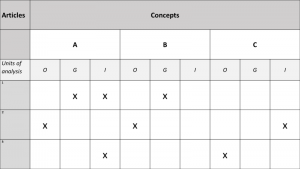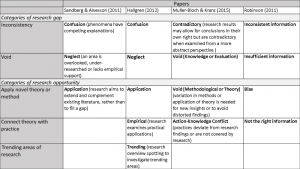The aim of all research is to add to or enhance existing knowledge. Arguably, we can only achieve this once we understand the work that has already been carried out in a given field. There are varying opinions, depending on the field of inquiry and methodological approach involved, regarding the level of familiarity a researcher should have with existing literature prior to commencing fieldwork, however it is generally accepted that research should fill gaps in the literature. It is perhaps surprising, then, that so little is written about just how to find a “research gap” in the first place.
Finding the literature
The most obvious way to find a research gap is simply to read and analyse the relevant literature. However, this is easier said than done, as the volume of published literature can be staggering. Fortunately, there are some excellent bibliographic databases, which can speed the process of searching for relevant literature. Literature analysis may then be approached either qualitatively or quantitively.
Qualitative literature analysis
A qualitative analysis may involve the development of a concept matrix (Webster & Watson, 2002) or similar.
Figure 1: Example of a concept matrix (adapted from Webster & Watson, 2002)
Legend: O (organisation), G (group), I (individual)
The concept matrix assists researchers to organise the literature they have read, according to the concepts it relates to. It can be adapted, depending on the area of interest. In the example above, for instance, units of analysis are included.
Quantitive literature analysis
Quantitative analysis of literature may be carried out using a variety of tools, from systematic reviews to meta-analyses, citation analyses, and text mining (Marrone, 2017). Choice of tools may be determined to some extent by the ability of the researcher to acquire or access the technical expertise to leverage them.
Find the gap, or create one?
Reading and analysing the literature may reveal gaps which can be explored, however Alvesson & Sandberg (2011) suggest that research gaps may also be created by the researcher. By linking together work which has previously been considered separately, a researcher can uncover uncharted territory. In this way, opportunities to contribute to existing knowledge are constructed (Locke & Golden-Biddle, 1997) rather than merely identified.
What does a “research gap” look like?
Several authors have sought to characterise research gaps, describing the various forms they can take, whether considered from the perspective of objectively identifiable existing gaps in research (gap finding) or as opportunities to construct new “gaps” (gap creation). Some examples are summarised below.
Gap-finding frameworks
Step-by-step guides to finding research gaps are hard to come by, however in the field of medical epidemiology, a framework for identifying research gaps from systematic reviews of literature has been published (Robinson et al., 2011). In this field, the PICOS framework (Population, Intervention, Comparison, Outcome, Setting) is commonly used to characterise a research gap. Robinson et al. (2011) suggest that an analysis of the reason for the existence of the gap can further inform the development of research questions. The reasons elucidated by Robinson et al. (2011) for the existence of research gaps are similar to the characteristics of gaps described by other authors, as shown in figure 2 (Characteristics of Research Gaps).
There are many ways to go about identifying research gaps, perhaps so many that the options may on occasion be overwhelming. A considered approach, coupled with knowledge and utilisation of the tools available to assist in research gap-finding, is likely to result in improved research design.
References
- Alvesson, M., & Sandberg, J. (2011). Generating research questions through problematization. Academy of Management Review. 36(2), 247-271 [doi:10.5465/AMR.2011.59330882]
- Hallgren, M. (2012) The construction of research questions in project management. International Journal of Project Management, 30(7), 804-816.
- Locke, K., & Golden-Biddle, K. (1997) Constructing opportunities for contribution: Structuring intertextual coherence and “problematizing” in organizational studies. Academy of Management Journal, 40: 1023–1062.
- Muller-Bloch, C. & Kranz, J. (2015) A framework for rigorously identifying research gaps in qualitative literature reviews. International Conference on Information Systems 2015 [available at: https://aisel.aisnet.org/icis2015/proceedings/ResearchMethods/2/]
- Marrone, M., & Hammerle, M. (2017). Relevant Research Areas in IT Service Management: An Examination of Academic and Practitioner Literatures. Communications of the Association for Information Systems, 41, 517-543.
- Robinson, K. A., Saldanha, I. J. & McKoy, N. A. (2011) Development of a framework to identify research gaps from systematic reviews. Journal of Clinical Epidemiology, 64(12), 1325-1330.
- Sandberg, J., & Alvesson, M. 2011. Ways of constructing research questions: Gap-spotting or problematization? Organization, 18: 23–44.
- Webster, J., & Watson, R. T. (2002). Analyzing the past to prepare for the future: Writing a literature review. MIS Quarterly, 26(2), 13-23



